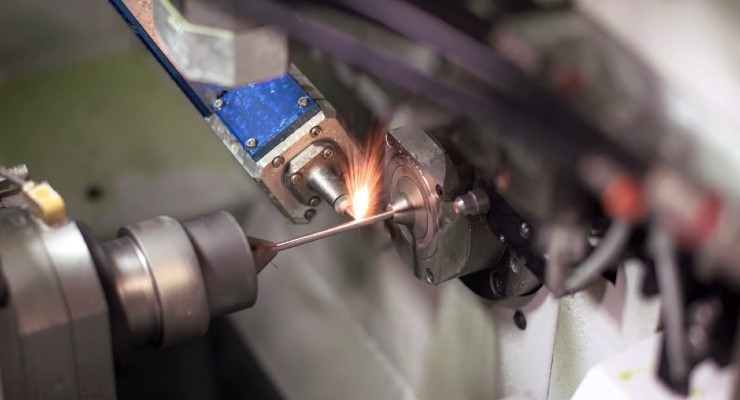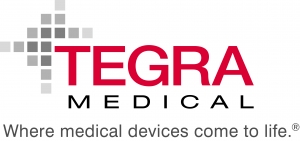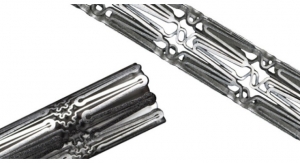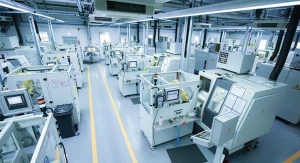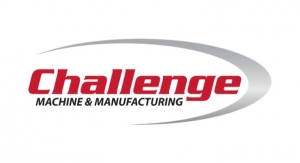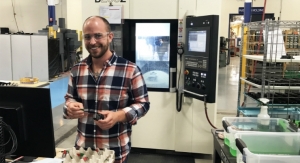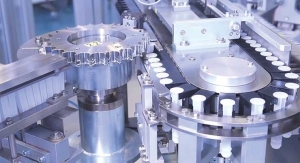Sam Brusco, Associate Editor02.24.20
Surgical equipment, catheters and delivery systems, stents, medical pumps, and parts for various implantable devices are all commonly manufactured using machining and laser processing. However, these methods have to be upgraded to meet the demands of medical device manufacturers.
The cornerstone methods of five-axis machining and Swiss turning are evolving beyond their original purposes to include multitasking capabilities, so the machining center can completely machine components in a single handling. Lasers can be used to micromachine many materials to the necessary and intricate and precise geometries of implantable devices. Ultrashort-pulse lasers are becoming an attractive option because they minimize damage and allow precise processing of more complex medical device components. Hybrid systems are even combining Swiss turning and laser cutting/welding, or additive and subtractive processes in one work area.
Like all manufacturing, machining and laser processing operations are trending toward “Industry 4.0”—a streamlined, intelligent, connected network of machines, devices, and systems. In time, connected processes may well replace conventional machines or be synchronized with legacy systems to ensure large data streams are available. These additions can track machine performance, and optimize logistics and supply chains.
To gather insight on the trends and challenges impacting machining and laser processing equipment services for medical device and component manufacturing, I spoke with MW Industries, a Rosemont, Ill.-based manufacturer of highly-engineered industrial springs, fasteners, bellows, and related metal components.
The full extent of the company's input was not included in the recent feature article “Machining Moves to Modernize with Industry 4.0,” so the entirety of our conversation is included in the Q&A below.
Sam Brusco: What machining/laser processing services do you offer, and (generally speaking) what sorts of medical components might they be used to fabricate?
MW: We manufacture high precision and process validated components and assemblies for the medical device and pharmaceutical auto-injection markets.
Our in-house laser services include laser welding, laser cutting and hybrid laser Swiss machining. Our custom laser welding/cutting platforms include full CNC control with 4th axis rotational capability. These platforms include a large operating window and are truly open concept to accept any size part or fixture. Each platform is equipped with a 300/3000QCW laser system which can be optimized for a large variety of parts.
Beyond laser welding and cutting, we offer Laser Swiss machining capability. A hybrid machine that includes traditional Swiss machining with the addition of a laser cutting/welding tool. Combine this technology with the manufacturing engineering support at Economy Spring and we can provide limitless possibilities to the medical market design groups.
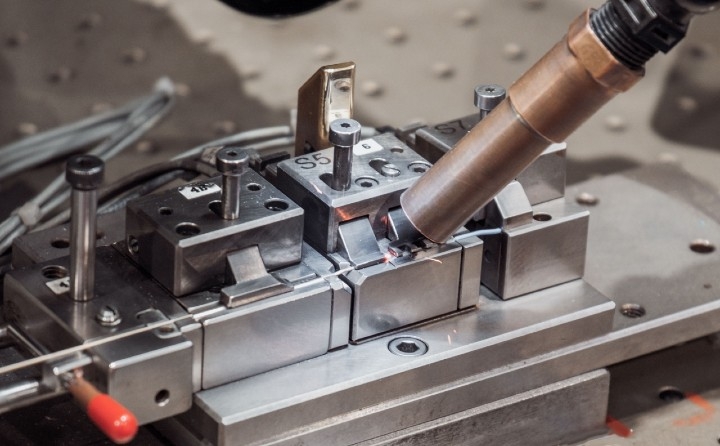
Laser welding of medical instruments using precision tooling.
Brusco: If your operations include hybrid machining, please describe them. What benefits can be found in using hybrid machining to manufacture parts?
MW: Our hybrid approach takes the traditional Swiss turning machine and combines that with laser cutting/welding technology. We have a variety of Citizen L220 Type 8 and Type 12 machines including one of the first 5 released in the United States. Citizen-Cincom got with a local laser expert to integrate a laser cutting head inside the machine to replace one of the live tooling posts. With this technology released to the world, we now we have the ability to turn, mill, and do all the operations done in a high-precision Citizen Swiss machine, with the additional capabilities of laser cutting and laser welding.
This is a huge benefit—multiple operations are already eliminated because there’s so much capability inside the machine by itself. Adding the laser capability eliminates yet another operation that would have been something interior if you went about it in a traditional manner.
Brusco: What skill sets are required for machine/laser operators in order to be successful in a modern manufacturing environment?
MW: You need to have a machinist trade background that includes CNC programming abilities. The difference in the modern manufacturing environment is the laser process. You are primarily not going to find people with both disciplines and if you do you hit the jackpot! Since laser technology is advancing every day, we make it priority to stay ahead of it. We work closely with laser experts and training facilitators to keep our Machinist/Operators up to date.
Brusco: What are you seeing in people being trained: are they coming trained? Are they changing from one job to another? Are they interns that learn and go back to college, then come work for us?
MW: We’re new to this, so we’re learning as we go. Laser machining has been around for a very long time, but it’s now required for medical applications. We rely on our partnerships with outside laser experts to support our business and build our experience, and make sure we’re following best laser machining and welding practices. We’re also providing the training and tools necessary to get people up to speed so they make the right decisions.
Sam: What “best practices” should medical device OEM customers consider for a successful manufacturing partnership?
MW: Medical device OEMs need to include the production manufacturer early in the design process. Too often a concept is produced at a prototype house and is not feasible for production manufacturing. Economy Spring provides prototyping/validation/production capabilities for this very reason. The design to production process can be extremely expensive and prolonged. We look to gain these partnerships to provide DFM and speed to market.
The cornerstone methods of five-axis machining and Swiss turning are evolving beyond their original purposes to include multitasking capabilities, so the machining center can completely machine components in a single handling. Lasers can be used to micromachine many materials to the necessary and intricate and precise geometries of implantable devices. Ultrashort-pulse lasers are becoming an attractive option because they minimize damage and allow precise processing of more complex medical device components. Hybrid systems are even combining Swiss turning and laser cutting/welding, or additive and subtractive processes in one work area.
Like all manufacturing, machining and laser processing operations are trending toward “Industry 4.0”—a streamlined, intelligent, connected network of machines, devices, and systems. In time, connected processes may well replace conventional machines or be synchronized with legacy systems to ensure large data streams are available. These additions can track machine performance, and optimize logistics and supply chains.
To gather insight on the trends and challenges impacting machining and laser processing equipment services for medical device and component manufacturing, I spoke with MW Industries, a Rosemont, Ill.-based manufacturer of highly-engineered industrial springs, fasteners, bellows, and related metal components.
The full extent of the company's input was not included in the recent feature article “Machining Moves to Modernize with Industry 4.0,” so the entirety of our conversation is included in the Q&A below.
Sam Brusco: What machining/laser processing services do you offer, and (generally speaking) what sorts of medical components might they be used to fabricate?
MW: We manufacture high precision and process validated components and assemblies for the medical device and pharmaceutical auto-injection markets.
Our in-house laser services include laser welding, laser cutting and hybrid laser Swiss machining. Our custom laser welding/cutting platforms include full CNC control with 4th axis rotational capability. These platforms include a large operating window and are truly open concept to accept any size part or fixture. Each platform is equipped with a 300/3000QCW laser system which can be optimized for a large variety of parts.
Beyond laser welding and cutting, we offer Laser Swiss machining capability. A hybrid machine that includes traditional Swiss machining with the addition of a laser cutting/welding tool. Combine this technology with the manufacturing engineering support at Economy Spring and we can provide limitless possibilities to the medical market design groups.

Laser welding of medical instruments using precision tooling.
Brusco: If your operations include hybrid machining, please describe them. What benefits can be found in using hybrid machining to manufacture parts?
MW: Our hybrid approach takes the traditional Swiss turning machine and combines that with laser cutting/welding technology. We have a variety of Citizen L220 Type 8 and Type 12 machines including one of the first 5 released in the United States. Citizen-Cincom got with a local laser expert to integrate a laser cutting head inside the machine to replace one of the live tooling posts. With this technology released to the world, we now we have the ability to turn, mill, and do all the operations done in a high-precision Citizen Swiss machine, with the additional capabilities of laser cutting and laser welding.
This is a huge benefit—multiple operations are already eliminated because there’s so much capability inside the machine by itself. Adding the laser capability eliminates yet another operation that would have been something interior if you went about it in a traditional manner.
Brusco: What skill sets are required for machine/laser operators in order to be successful in a modern manufacturing environment?
MW: You need to have a machinist trade background that includes CNC programming abilities. The difference in the modern manufacturing environment is the laser process. You are primarily not going to find people with both disciplines and if you do you hit the jackpot! Since laser technology is advancing every day, we make it priority to stay ahead of it. We work closely with laser experts and training facilitators to keep our Machinist/Operators up to date.
Brusco: What are you seeing in people being trained: are they coming trained? Are they changing from one job to another? Are they interns that learn and go back to college, then come work for us?
MW: We’re new to this, so we’re learning as we go. Laser machining has been around for a very long time, but it’s now required for medical applications. We rely on our partnerships with outside laser experts to support our business and build our experience, and make sure we’re following best laser machining and welding practices. We’re also providing the training and tools necessary to get people up to speed so they make the right decisions.
Sam: What “best practices” should medical device OEM customers consider for a successful manufacturing partnership?
MW: Medical device OEMs need to include the production manufacturer early in the design process. Too often a concept is produced at a prototype house and is not feasible for production manufacturing. Economy Spring provides prototyping/validation/production capabilities for this very reason. The design to production process can be extremely expensive and prolonged. We look to gain these partnerships to provide DFM and speed to market.

